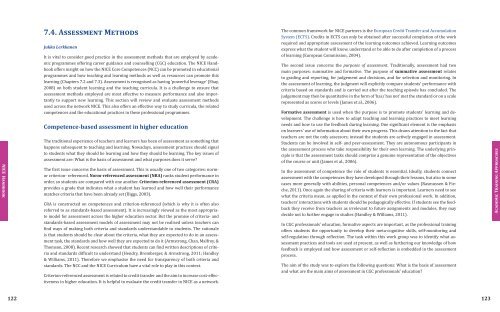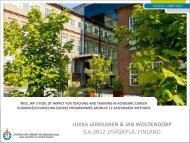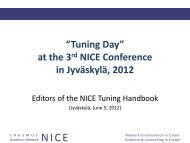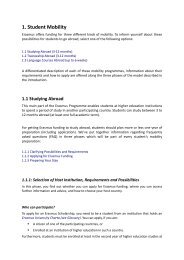NICE HANDBOOK â Academic training of Career ... - Nice-network.eu
NICE HANDBOOK â Academic training of Career ... - Nice-network.eu
NICE HANDBOOK â Academic training of Career ... - Nice-network.eu
You also want an ePaper? Increase the reach of your titles
YUMPU automatically turns print PDFs into web optimized ePapers that Google loves.
<strong>NICE</strong> Handbook7.4. Assessment MethodsJukka LerkkanenIt is vital to consider good practice in the assessment methods that are employed by academicprogrammes <strong>of</strong>fering career guidance and counselling (CGC) education. The <strong>NICE</strong> Handbook<strong>of</strong>fers insight on how the <strong>NICE</strong> Core Competences (NCC) can be promoted in educationalprogrammes and how teaching and learning methods as well as resources can promote thislearning (Chapters 7.2 and 7.3). Assessment is recognised as having ‘powerful leverage’ (Shay,2008) on both student learning and the teaching curricula. It is a challenge to ensure thatassessment methods employed are most effective to measure performance and also importantlyto support new learning. This section will review and evaluate assessment methodsused across the <strong>network</strong> <strong>NICE</strong>. This also <strong>of</strong>fers an effective way to study curricula, the relatedcompetences and the educational practices in these pr<strong>of</strong>essional programmes.Competence-based assessment in higher educationThe traditional experience <strong>of</strong> teachers and learners has been <strong>of</strong> assessment as something thathappens subsequent to teaching and learning. Nowadays, assessment practices should signalto students what they should be learning and how they should be learning. The key issues <strong>of</strong>assessment are: What is the basis <strong>of</strong> assessment and what purposes does it serve?The first issue concerns the basis <strong>of</strong> assessment. This is usually one <strong>of</strong> two categories: normorcriterion- referenced. Norm-referenced assessment (NRA) ranks student performance inorder, so students are compared with one another. Criterion-referenced assessment (CRA)provides a grade that indicates what a student has learned and how well their performancematches criteria that have been already set (Biggs, 2003).CRA is constructed on competences and criterion-referenced (which is why it is <strong>of</strong>ten alsoreferred to as standards-based assessment). It is increasingly viewed as the most appropriatemodel for assessment across the higher education sector. But the promise <strong>of</strong> criteria- andstandards-based assessment models <strong>of</strong> assessment may not be realised unless teachers canfind ways <strong>of</strong> making both criteria and standards understandable to students. The rationaleis that students should be clear about the criteria, what they are expected to do in an assessmenttask, the standards and how well they are expected to do it (Armstrong, Chan, Malfroy, &Thomson, 2008). Recent research showed that students can find written descriptions <strong>of</strong> criteriaand standards difficult to understand (Hendry, Bromberger, & Armstrong, 2011; Handley& Williams, 2011). Therefore we emphasise the need for transparency <strong>of</strong> both criteria andstandards. The NCC and the <strong>NICE</strong> Curriculum have a vital role to play in this context.Criterion-referenced assessment is related to credit transfer and the aim to increase cost-effectivenessin higher education. It is helpful to evaluate the credit transfer in <strong>NICE</strong> as a <strong>network</strong>.The common framework for <strong>NICE</strong> partners is the European Credit Transfer and AccumulationSystem (ECTS). Credits in ECTS can only be obtained after successful completion <strong>of</strong> the workrequired and appropriate assessment <strong>of</strong> the learning outcomes achieved. Learning outcomesexpress what the student will know, understand or be able to do after completion <strong>of</strong> a process<strong>of</strong> learning (European Commission, 2004).The second issue concerns the purposes <strong>of</strong> assessment. Traditionally, assessment had twomain purposes: summative and formative. The purpose <strong>of</strong> summative assessment relatesto grading and reporting, for judgement and decisions, and for selection and monitoring. Inthe assessment <strong>of</strong> learning, the judgment will explicitly compare students’ performance withcriteria based on standards and is carried out after the teaching episode has concluded. Thejudgement may then be quantitative in the form <strong>of</strong> ‘has/ has not’ met the standard or on a scalerepresented as scores or levels (James et al., 2006).Formative assessment is used when the purpose is to promote students’ learning and development.The challenge is how to adapt teaching and learning practices to meet learningneeds and how to use the feedback during learning. One significant element is the emphasison learners’ use <strong>of</strong> information about their own progress. This draws attention to the fact thatteachers are not the only assessors; instead the students are actively engaged in assessment.Students can be involved in self- and peer-assessment. They are autonomous participants inthe assessment process who take responsibility for their own learning. The underlying principleis that the assessment tasks should comprise a genuine representation <strong>of</strong> the objectives<strong>of</strong> the course or unit (James et al., 2006).In the assessment <strong>of</strong> competence the role <strong>of</strong> students is essential. Ideally, students connectassessment with the competences they have developed through their lessons, but also in somecases more generally with abilities, personal competences and/or values (Rasmussen & Fieche,2011). Once again the sharing <strong>of</strong> criteria with learners is important. Learners need to seewhat the criteria mean, as applied in the context <strong>of</strong> their own pr<strong>of</strong>essional work. In addition,teachers’ interactions with students should be pedagogically effective. If students see the feedbackthey receive from teachers as irrelevant to future assignments and modules, they maydecide not to further engage in studies (Handley & Williams, 2011).In CGC pr<strong>of</strong>essionals’ education, formative aspects are important, as the pr<strong>of</strong>essional <strong>training</strong><strong>of</strong>fers students the opportunity to develop their meta-cognitive skills, self-monitoring andself-regulation through reflection. The task within this work group was to identify what assessmentpractices and tools are used at present, as well as furthering our knowledge <strong>of</strong> howfeedback is employed and how assessment or self-reflection is embedded in the assessmentprocess.The aim <strong>of</strong> the study was to explore the following questions: What is the basis <strong>of</strong> assessmentand what are the main aims <strong>of</strong> assessment in CGC pr<strong>of</strong>essionals’ education?<strong>Academic</strong> Training Approaches122 123






